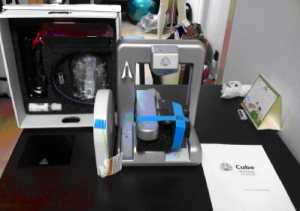 3D printing / additive manufacturing market is about to experience much broader adoption across more upstream production applications and the consumer end market and as such our baseline assumptions project a slightly steeper trajectory than industry estimates. In the past 3D printers were seen as too slow to manufacture true production parts or end-use products and the machines / materials too expensive and technical expertise threshold too high for the average consumer. However, things are changing fast and 3D printers will play a Big Role in the next league of Industrial Manufacturing and shaping Human Lives.
3D printing / additive manufacturing market is about to experience much broader adoption across more upstream production applications and the consumer end market and as such our baseline assumptions project a slightly steeper trajectory than industry estimates. In the past 3D printers were seen as too slow to manufacture true production parts or end-use products and the machines / materials too expensive and technical expertise threshold too high for the average consumer. However, things are changing fast and 3D printers will play a Big Role in the next league of Industrial Manufacturing and shaping Human Lives.
Currently, 3D Printing accounts for less than 10-15% of $2B+ in revenue generated in the prototyping and pre-production mold industry, but we expect it to contribute more meaningfully over the next 3-10 years as global manufacturers incorporate the technology in an effort to gain any edge to differentiate against the competition. By 2015 expect revenue contribution from advance manufacturing applications using 3D printers to account for close to $800M or 20% of the industry.
The technology has been shown to help manufacturers improve time to market by speeding up the iterative design process. In small batch production and for customized end products, the cost of 3D printing can be meaningfully below traditional manufacturing processes. Microsoft uses the technology extensively in the design process of their PC hardware and accessories. General Electric has not only produced engine parts for its next generation LEAP engine but has also invested heavily in the technology with acquisitions of large 3D print service bureaus.
Stratasys and Makerbot recently estimated that 35-40K desktop 3D printers were sold in 2012 and projected this figure to double in 2013. There remains a great deal of uncertainty around the trajectory of the consumer market with skeptics questioning the use case for the device. While we are not yet convinced the technology will be in every home, we do believe that consumer 3D printers could eventually be a multi-million unit opportunity (annual).
3D Printers Market Size and Pricing
The 3D printers Adoption will be closer to devices such as the fax machine and video camcorders which had a specific value proposition to a large demographic but not the entire population. Adoption for these types of products typically inched up over time hitting ~10% after ten years, eventually reaching ~60-70% of households over the product life.
The average selling price of professional 3D printers has fallen dramatically since 2001 from $117K to ~$80K. We recognize that a consumer would never pay $80K for a printer, but the chart does illustrate for us the downward pressure that the industry is seeing on price. The recent Maker movement building on the RepRap open source initiative has resulted in a flood of cheap consumer-oriented manufacturers such as Makerbot entering the market.3D Systems Cube printer is currently priced at $1,200.